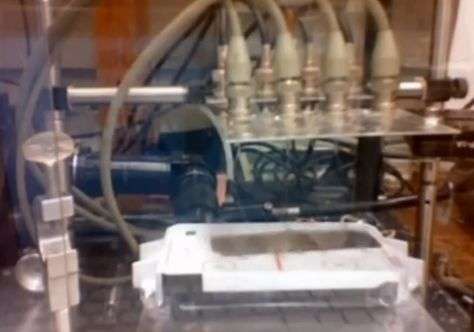October 1, 2011 weblog
'Flying carpet': Princeton team's plastic sheet can hover above ground (w/ video)

(PhysOrg.com) -- A thin sheet of plastic has been making headlines at Princeton as a magical flying carpet, after the publication of a paper describing experiments by the team with their prototype sheet of plastic that uses piezoelectric actuators and sensors to move. The sensors and conducting threads create "ripples" of air moving front to back of the sheet, and the sheet is propelled into the air.
The creator, graduate student Noah Jafferis, and team described their device and findings in Applied Physics Letters, which published their article online earlier this month.
"We use integrated piezoelectric actuators and sensors to demonstrate the propulsive force produced by controllable transverse traveling waves in a thin plastic sheet suspended in air above a flat surface, thus confirming the physical basis for a 'flying' carpet near a horizontal surface," wrote the three authors, Noah Jafferis, Howard Stone, and James Sturm. “Experiments are conducted to determine the dependence of the force on the height above the ground and the amplitude of the traveling wave, which qualitatively confirm previous theoretical predictions.”
The undulating ripples allow the sheet to move at a speed of a centimeter per second, and Jafferis believes it should be possible to increase the speed to about a meter per second.
An earlier paper written by Harvard Professor Lakshminarayanan Mahadevan inspired Jafferis to look into his hovering plastic sheet project shortly after starting his doctoral studies. Jafferis at the time had been on another project, printing electronic circuits with nano-inks. Instead he turned to the plastic sheet project and spent two years working on sensors and performance improvements.
A BBC interviewer was told by Sturm that it was not easy to control the sheet's behavior as it deformed at high frequencies.
Even though news reports are referring to the sheet as a flying carpet, weaknesses in propulsion and lift hardly make the device comparable to magic carpets. Jafferis is careful to point out that flying should be in quotes because the object does not fly, nor does it go fast. The sheet hovers above the ground as electric ripples flow, moving air along its underside.
Jafferis points out that the prototype’s tiny conducting threads anchor it to heavy batteries. On the development agenda is a solar-powered upgrade that could enable it to fly over large distances.
Applications for such a device, according to reports, might include a planet Mars rover. Prof Mahadevan looks forward to sophisticated improvements in the near future, suggesting the approach could progress to "mimicking the beautiful two-dimensional undulations of the skate or manta ray.”
More information: Traveling wave-induced aerodynamic propulsive forces using piezoelectrically deformed substrates, Appl. Phys. Lett. 99, 114102 (2011); doi:10.1063/1.3637635
Abstract
We use integrated piezoelectric actuators and sensors to demonstrate the propulsive force produced by controllable transverse traveling waves in a thin plastic sheet suspended in air above a flat surface, thus confirming the physical basis for a “flying” carpet near a horizontal surface. Experiments are conducted to determine the dependence of the force on the height above the ground and the amplitude of the traveling wave, which qualitatively confirm previous theoretical predictions.
via BBC
© 2011 PhysOrg.com

















